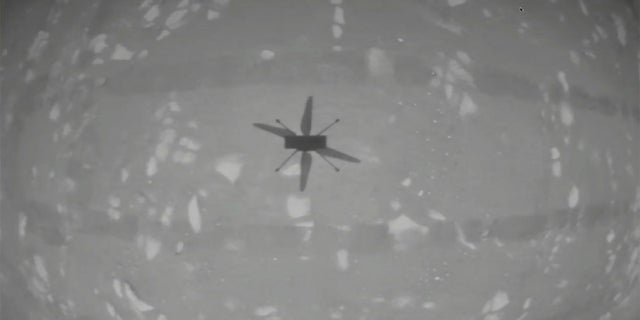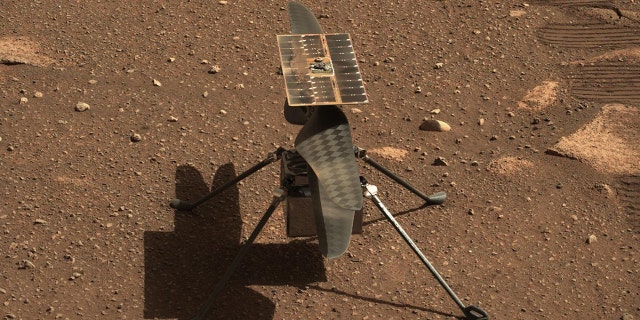NASA Ingenuity Mars helicopter makes history with first powered, controlled flight on another planet

[ad_1]
NASA has made history Monday with its Ingenuity Mars helicopter completing the first-ever powered, controlled flight on another planet.
The whole flight in the Jezero Crater flight zone was expected to last around 40 seconds, with Ingenuity lifting off climbing at a rate of 3 feet per second, rotating, taking images with a 13-megapixel camera and hovering at 10 feet above the surface.
“Ingenuity has performed its first flight — the first flight of a powered aircraft on another planet!” flight control was heard saying in audio broadcast Monday morning by NASA.

NASA’s Mars helicopter Ingenuity hovers above the surface of Mars on Monday. (NASA/AP)
EXPEDITION 64 CREW MEMBERS RETURN FROM INTERNATIONAL SPACE STATION
Flight controllers in California confirmed Ingenuity’s brief hop after receiving data via the Perseverance rover, which stood watch more than 200 feet away. Ingenuity hitched a ride to Mars on Perseverance, clinging to the rover’s belly upon their arrival in an ancient river delta in February.
“We’ve been talking for so long about our Wright brothers moment,” Ingenuity project manager MiMi Aung added. “And here it is.”
The $85 million helicopter demo was considered high risk, yet high reward.

NASA’s experimental Mars helicopter Ingenuity lands on the surface of Mars on Monday. (NASA/AP)
NASA had been aiming for a 40-second flight, and while details were initially sparse, the craft hit all its targets: spin-up, takeoff, hover, descent and landing.
To achieve the flight, the helicopter’s twin, counter-rotating rotor blades needed to spin at 2,500 revolutions per minute — five times faster than on Earth. With an atmosphere just 1% the thickness of Earth’s, engineers had to build a helicopter light enough — with blades spinning fast enough — to generate this otherworldy lift. At the same time, it had to be sturdy enough to withstand the Martian wind and extreme cold.
NASA SATELLITE DATA COULD DETECT VOLCANIC UNREST YEARS BEFORE ERUPTIONS
More than six years in the making, Ingenuity is a barebones 1.6 feet tall, a spindly four-legged chopper. Its fuselage, containing all the batteries, heaters and sensors, is the size of a tissue box. The carbon-fiber, foam-filled rotors are the biggest pieces: Each pair stretches 4 feet tip to tip.
The helicopter is topped with a solar panel for recharging the batteries, crucial for its survival during the minus-130 degree Fahrenheit Martian nights.
NASA chose a flat, relatively rock-free patch for Ingenuity’s airfield, measuring 33 feet by 33 feet.
It turned out to be less than 100 feet from the original landing site in Jezero Crater. The helicopter was released from the rover onto the airfield on April 3. Flight commands were sent Sunday, after controllers sent up a software correction for the rotor blade spin-up.

NASA’s Ingenuity Mars helicopter is seen here in a close-up taken by Mastcam-Z, a pair of zoomable cameras aboard the Perseverance rover. (NASA/JPL-Caltech/ASU)
CLICK HERE TO GET THE FOX NEWS APP
Up to five helicopter flights are planned, each one increasingly ambitious. If successful, the demo could lead the way to a fleet of Martian drones in decades to come, providing aerial views, transporting packages and serving as scouts for astronauts. High-altitude helicopters here on Earth could also benefit — imagine choppers easily navigating the Himalayas.
Ingenuity’s team has until the beginning of May to complete the test flights. That’s because the rover needs to get on with its main mission: collecting rock samples that could hold evidence of past Martian life, for return to Earth a decade from now.
Fox News’ Julia Musto and The Associated Press contributed to this report.
[ad_2]
Source link




